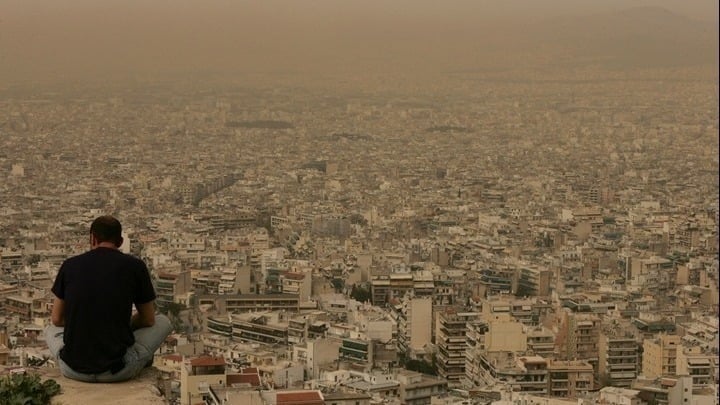

A massive dust cloud originating from the Sahara Desert has swept across the eastern Mediterranean, cloaking large parts of Greece in a dense, ochre-colored haze. From the capital city of Athens to the southern island of Crete, visibility has plummeted, and public health alerts have been issued.
The phenomenon has left much of the country under a blanket of airborne particles, creating an eerie orange tint in the sky. The southern island of Crete has been hit especially hard, with residents reporting poor air quality and dust settling visibly on buildings and vehicles.
Authorities have advised vulnerable groups—including the elderly, children, and individuals with respiratory conditions—to avoid outdoor activities, particularly during peak exposure hours.

The dust from Africa is not just a visual or respiratory nuisance—it carries significant health risks. Numerous studies by Greek and international researchers have shown that African dust clouds often transport toxic heavy metals such as lead, arsenic, nickel, chromium, vanadium, and zinc.
These substances, when inhaled, are associated with a rise in hospital admissions, particularly for respiratory and cardiovascular issues. The fine particulate matter (PM10 and PM2.5) in the dust can penetrate deep into the lungs and enter the bloodstream, posing risks even to otherwise healthy individuals.
Over the last decade, Greece has seen a noticeable increase in the frequency and intensity of these dust events, a trend attributed to intensifying desertification in the Sahara due to climate change.
The primary engine behind these airborne dust events is the Bodélé Depression in northern Chad, a dried-up lakebed that serves as one of the most prolific dust-producing regions on the planet. When strong winds—ranging from 13 to 35 mph (6–16 m/s)—blow through the depression, they lift massive volumes of fine sediment high into the atmosphere.
These winds can carry Saharan dust thousands of kilometers, affecting regions across Southern Europe, the Middle East, and even the Americas. The dust’s journey is aided by seasonal weather patterns, with the most significant dispersal occurring from spring through autumn.
The Sahara Desert is the largest source of aeolian (wind-borne) dust on Earth, contributing between 400 to 700 million tons of dust to the atmosphere each year. This represents nearly half of the global desert dust that reaches the oceans.
Although Saharan dust storms are largely driven by natural processes, such as climatic patterns and wind systems, their increasing frequency and impact on human populations are being closely monitored by scientists and public health officials alike.
With climate change exacerbating desertification and altering wind patterns, dust events like these are expected to become more common in Greece and across the Mediterranean. Officials stress the need for better air quality monitoring, public health readiness, and international collaboration to understand and mitigate the long-term impacts of Saharan dust intrusions.
For now, Greeks are urged to limit outdoor exposure, use air purifiers where possible, and stay informed through local health advisories.
